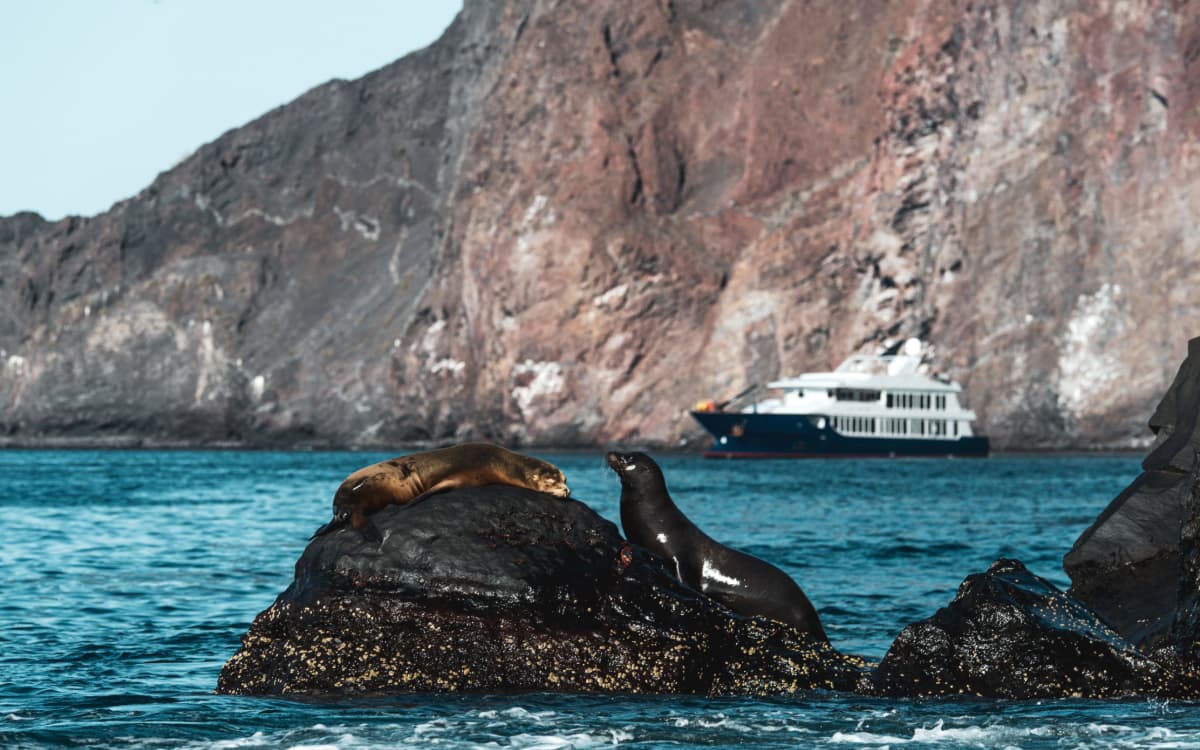Wanderlust

Apr 19, 2017
Trails of Discovery in Peru
Written by
Amanda McKee

“Think of the Inca Empire as a body,” explained our guide Bruno. “Cusco is the heart, the Inca trails are the veins, and the Inca cities are the organs.” We had just climbed to the pinnacle of Ancasmarca, a far-flung Incan site perched around 13,500 feet above sea level with steep hillsides blanketed in crumbling circular storehouses. Surrounding us were beautiful, rocky mountains whose yellow and black slopes were dotted with humble farmsteads. We were the only visitors and I stood in awe—for the third time in two days.
While Bruno described the importance of this site, strategically situated along one of the main Inca trail arteries near a pass that connected Cusco to the jungle, I felt transported back in time. I imagined this outpost at its height, with granaries full of dehydrated food to help sustain the population in case of crop failure, with visiting traders bearing coca and feathers from the Amazon, and with Inca soldiers stopping in to collect clothes, comestibles, tools, and weapons en route to expand their empire.
“This is lupine,” Bruno said, holding out a purple flower and pulling me from my reverie. “It has been domesticated to be edible. The pods are a good source of calcium and iron.” Just then a juvenile caracara (a type of falcon) soared overhead, blocking the sun for a split second. I was astounded by the interplay of nature and history and the ingenuity of man.
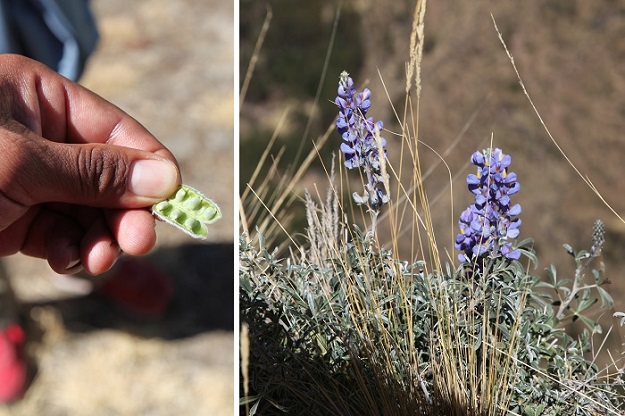 Lupine flower and edible pods. Photos: Amanda McKee
We had left Cusco the day before, descending into the Sacred Valley of the Incas to kick off our five-day hiking trip that would travel through the isolated Lares Valley and culminate at Machu Picchu. I was astonished by the loft and mass of the Andes, by their towering golden grace, their agricultural terraces, and their snowcapped peaks. I also couldn’t believe the number of minor Incan ruins we’d seen in passing from the road—and I pointed excitedly at each one, betraying my status as an eager first-time Peru visitor.
But my eyes only grew wider throughout the day, first as we hiked from the little farming village of Amaru (me at a snail’s pace, gulping oxygen every step of the way) to the breathtaking 14,200-foot Challwacasa Pass, which offered sensational views of the Vilcanota Range one way and distant 20,574-foot Salcantay the other. (A shepherd and his flock of fluffy sheep trotting easily along next to us provided a nice distraction from the thin air, as did little Johan, the son of Raina, who was leading the donkey to support our hike). Elated to have made it to the day’s summit, I gazed out on the sea of overlapping ridges spanning to the horizon in complete wonderment.
 Johan and our support donkey, named Justy (short for “just in case”). Photo: Amanda McKee
The most stunning sight of the day, however, came four hours later, after we’d refueled with a pachamanca (traditional earth oven) lunch, gotten a primer in Peru’s 3,000 potato varieties, and descended through fields of rust-colored quinoa, passing a few kids returning from school. There, capping a hilltop below us was the ancient citadel of Pisac: its buildings of meticulously carved pink granite glowing in the late-afternoon light, its agricultural terraces falling away from it like a cape draping the shoulders of a giant.
“How can Machu Picchu be any more impressive?” I wondered to my fellow hiker, awestruck. We zigzagged down the vertical gorge and crossed the river to the Incan fortress, one of the vital “organs” Bruno would later mention at Ancasmarca. As we joined Pisac’s last visitors of the day, who’d arrived by car, and climbed to the Temple of the Sun—“It aligns perfectly with the sunrise on the winter solstice,” Bruno shared—I was grateful for the much more dramatic approach we’d had on foot, holding onto the scenes in my mind like a guilty secret.
 Hiking down to the Pisac archaeological site. Photo: Amanda McKee
The power of the Inca Empire struck me at Pisac, as of course did the mind-boggling skill of its stonemasons and engineers, but when I was taking in the dilapidated ruins of isolated Ancasmarca, I was more conscious of the empire’s broad reach—when the Spanish arrived in 1532, the Incan territory spanned from Chile to Colombia. Its demise also felt more palpable here. I appreciated this unsung archaeological site for its rawness, remoteness, and relative anonymity. I felt captivated by the delicious loneliness of the place. We were really getting away from it all.
Leaving Ancasmarca and the Sacred Valley behind, we wound up up up a paved road just wide enough for one vehicle toward a glacier, passing llamas and hardy farms and stopping here and there to offer bread and fruit to kids waving to us along the way (bakeries and markets are a long walk from here). After cresting Lares Pass at 14,635 feet, we followed tumbling streams past lovely waterfalls to a rushing river, beeping around every blind corner, hugging a strip of asphalt that dangled precariously on the edge of a cliff, no guardrail in sight.
Deeper into the back beyond we went, turning our attention from Incan remains to the living indigenous cultures of the greater Lares Valley. We hiked up and over Quelquena Pass at 12,595 feet, savoring sublime Andean vistas and greeting a few colorfully clad locals who were walking between villages. “Allillanchu,” I attempted in my best Quechua. “Allillanmi,” they replied smiling, likely at my poor pronunciation.
 View from Quelquena Pass at 12,595 feet. Photo: Amanda McKee
I felt on top of the world and far from civilization, a notion that was reinforced come nightfall when I looked up from my hot tub at Huacahuasi Lodge to see the sky positively pulsing with stars. It was as though I was swimming in the Milky Way.
While the water soothed my tired legs, my eyes investigated the bright constellations and the dark spaces between the stars, trying to pick out the forms the Incas saw in the Milky Way. Worshipers of nature, the Incas believed in a strong connection between the stars and the earth, and saw sacred spirits and animals reflected in both realms. “The Milky Way was the Celestial River,” Bruno had told us during the hike. “It mirrored the Urubamba River and the surrounding Sacred Valley, and within it were forms like the llama and serpent, also represented in Incan architecture.” I couldn’t find the llama in the sky, but looked forward to seeing it laid out in stone at Ollantaytambo, an acclaimed Incan fortress and ceremonial center designed in the shape of this revered camelid.
The next day, with our sights set on Ollantaytambo, we embarked from the village of Huacahuasi for what turned out to be my favorite hike of the journey: an eight-mile trek across 14,646-foot Ipsaycocha Pass and down to the town of Patacancha. Now comfortable with the altitude, I reveled in the rugged peaks and waterfalls, in inquisitive alpacas, and in spotting the rabbit-like viscacha, Andean geese, and pintail ducks—as well as Wendy, who had taken over from Raina and Johan as trek support. She would zip ahead and then magically reappear perched on some rock or by some stream waiting patiently, the bright reds of her traditional garb catching our eyes.
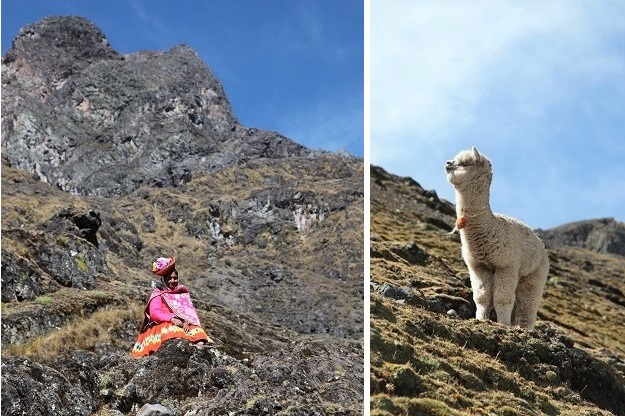 Wendy waiting for us (left) and an alpaca along the trail (right). Photos: Amanda McKee
The closer we got to town, the more locals appeared on the trail, happily exchanging hellos with us. Some women sat outside their homes selling textiles, and more agricultural terraces came into view left from Incan times. As the valley stretched out before us, I took photo after photo, knowing that I’d never capture the beauty of the landscape, the dance of the light as the sun flirted with the clouds, or the feeling that civilizations had moved here before us.
 Valley vista as we descend to the town of Patacancha. Photo: Amanda McKee
The following morning, before we hopped aboard the Inca Rail (the handy alternative to the four-day trek into Machu Picchu), Bruno led us up Pinkuylluna, a mountain across from the main Ollantaytambo site, to explore some lesser visited ruins that I found extraordinary. It was exhilarating to wander through these moldering structures with no other visitors and hear Bruno tell the tale of the Incas’ victory over the Spanish conquistadors here some 500 years before. (It didn’t take long, however, for the Spanish to return and drive out the Incas for good.) This elevated location also provided a perfect vantage point over the main site. “Do you see the llama?” Bruno asked, pointing. I felt a shock run through me as the lines around the agricultural terraces stitched into the shape of a back, the outline of the storehouses morphed into a tail, and the Temple of the Sun transformed into a face. “Yes!” I exclaimed, once again amazed by the Incas’ spirituality, level of devotion, and building mastery.
 The Incan site of Ollantaytambo, created in the shape of the sacred llama. Photo: Amanda McKee
And then came Machu Picchu, the legendary place that had originally ignited my fascination with Peru. As our train glided through the river canyon and dropped into the cloud forest, I wondered how seeing the Lost City of the Incas would be now that I’d spent time among other remarkable Incan sites and enjoyed being so wonderfully far from throngs of tourists. I readied myself for disappointment, and made my way nervously to the bus that carries visitors up the hairpin turns to the entry gate.
But the moment I stepped up to the iconic view of the sacred plaza and ceremonial baths, my worry vanished and my jaw dropped open. The crowds faded from my awareness and I just gaped at the gigantic, sensationally perched citadel, my head spinning in disbelief. This wasn’t some photo on the internet, or a dream. I was standing on an Incan-made terrace at Machu Picchu, watching clouds drift languidly by, smelling the earth and recent rain, following the arc of birds as they coasted on thermals, and thinking of the incredible effort it took to construct this city, in which some 500 people were thought to have lived. With vertical drop-offs all around, I felt suspended in midair, thousands of feet above the snaking Urubamba River, with nothing to catch me but the lush, orchid-filled cloud forest.
With a deep breath, I set off to explore every inch of the place, even managing to have some of its corners all to myself. Over the next day and a half, I made sure that Bruno pointed out Machu Picchu’s spirits, like the guardian puma (seen in the shape and detail of Wayna Picchu mountain), the lizard (formed by the city’s residential and industrial sectors), and the flying condor, messenger of the Sun, a likeness we could make out when looking at the entire citadel from high above—our reward for the knee-straining, sweat-inducing, one-and-a-half-hour hike straight up the oversized Incan steps to the summit of Cerro Machu Picchu.
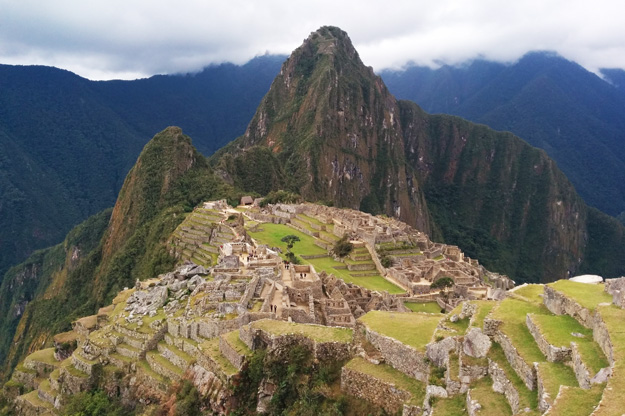 The ancient citadel of Machu Picchu. Photo: Amanda McKee
Standing there, I felt the learnings and experiences from my last five days coming together—the intriguing Incan sites, both known and unknown; the hair-raising tales of battles between the Incas and the Spanish; the gorgeous, deserted hiking trails on top of the Andes; the glowing fields of potatoes, barley, and quinoa; the friendly Quechua folks and high-altitude hamlets; the llamas and alpacas—and a sense of completeness washed over me.
#####
Amanda McKee is GeoEx’s Senior Editor. Her adventures have taken her from Bhutanese temples and Galápagos isles to Patagonian estancias, Uzbek mosques, and the summit of Mount Kilimanjaro.
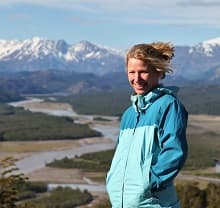
To start planning your own Peru adventure through the Lares Valley to Machu Picchu, visit Panoramas of Peru. GeoEx’s South America experts are also happy to chat with you about other options for Peru, and about tying them in with explorations in Ecuador, Chile, and more. Give them a call at 888-570-7108 to start the conversation.



